《管理学》课程PPT教学课件(Management, 7th Edition)Chapter 10 ORGANIZATIONAL STRUCTURE AND DESIGN
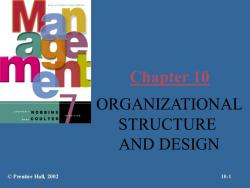
Chapter 10 ORGANIZATIONAL DROB BI NS ACOULTER STRUCTURE AND DESIGN ©Prentice Hall,.2002 10-1
Chapter 10 ORGANIZATIONAL STRUCTURE AND DESIGN © Prentice Hall, 2002 10-1
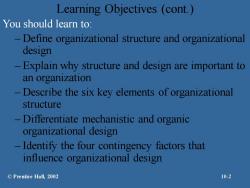
Learning Objectives (cont.) You should learn to: Define organizational structure and organizational design Explain why structure and design are important to an organization Describe the six key elements of organizational structure Differentiate mechanistic and organic organizational design Identify the four contingency factors that influence organizational design ©Prentice Hall,2002 10-2
Learning Objectives (cont.) You should learn to: – Define organizational structure and organizational design – Explain why structure and design are important to an organization – Describe the six key elements of organizational structure – Differentiate mechanistic and organic organizational design – Identify the four contingency factors that influence organizational design © Prentice Hall, 2002 10-2
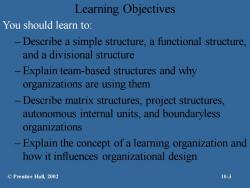
Learning Objectives You should learn to: Describe a simple structure,a functional structure, and a divisional structure Explain team-based structures and why organizations are using them Describe matrix structures,project structures. autonomous internal units,and boundaryless organizations Explain the concept of a learning organization and how it influences organizational design ©Prentice Hall,.2002 10-3
Learning Objectives You should learn to: – Describe a simple structure, a functional structure, and a divisional structure – Explain team-based structures and why organizations are using them – Describe matrix structures, project structures, autonomous internal units, and boundaryless organizations – Explain the concept of a learning organization and how it influences organizational design © Prentice Hall, 2002 10-3
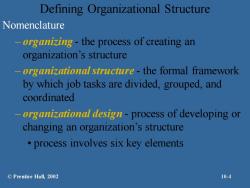
Defining Organizational Structure Nomenclature -orguikiing-the process of creating an organization's structure -organizational structure-the formal framework by which job tasks are divided,grouped,and coordinated -organizutionall design-process of developing or changing an organization's structure process involves six key elements ©Prentice Hal,2002 10-4
Defining Organizational Structure Nomenclature – organizing - the process of creating an organization’s structure – organizational structure - the formal framework by which job tasks are divided, grouped, and coordinated – organizational design - process of developing or changing an organization’s structure • process involves six key elements © Prentice Hall, 2002 10-4
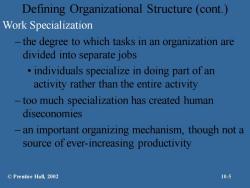
Defining Organizational Structure (cont. Work Specialization the degree to which tasks in an organization are divided into separate jobs individuals specialize in doing part of an activity rather than the entire activity too much specialization has created human diseconomies an important organizing mechanism,though not a source of ever-increasing productivity ©Prentice Hall,.2002 10-5
Defining Organizational Structure (cont.) Work Specialization – the degree to which tasks in an organization are divided into separate jobs • individuals specialize in doing part of an activity rather than the entire activity – too much specialization has created human diseconomies – an important organizing mechanism, though not a source of ever-increasing productivity © Prentice Hall, 2002 10-5
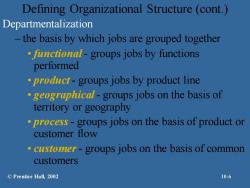
Defining Organizational Structure (cont.) Departmentalization -the basis by which jobs are grouped together tuctonall-groups jobs by functions performed prode-groups jobs by product line geograplicall-groups jobs on the basis of territory or geography process-groups jobs on the basis of product or customer flow cstoner-groups jobs on the basis of common customers ©Prentice Hall,.2002 10-6
Defining Organizational Structure (cont.) Departmentalization – the basis by which jobs are grouped together • functional - groups jobs by functions performed • product - groups jobs by product line • geographical - groups jobs on the basis of territory or geography • process- groups jobs on the basis of product or customer flow • customer - groups jobs on the basis of common customers © Prentice Hall, 2002 10-6
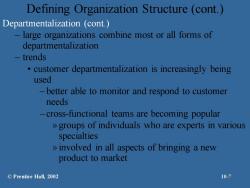
Defining Organization Structure(cont.) Departmentalization (cont.) -large organizations combine most or all forms of departmentalization 一 trends customer departmentalization is increasingly being used -better able to monitor and respond to customer needs -cross-functional teams are becoming popular >groups of individuals who are experts in various specialties >>involved in all aspects of bringing a new product to market ©Prentice Hall,2002 10-7
Defining Organization Structure (cont.) Departmentalization (cont.) – large organizations combine most or all forms of departmentalization – trends • customer departmentalization is increasingly being used – better able to monitor and respond to customer needs – cross-functional teams are becoming popular »groups of individuals who are experts in various specialties »involved in all aspects of bringing a new product to market © Prentice Hall, 2002 10-7

Functional Departmentalization Plant Manager Manager Manager, Manager Manager Manager Engineering Accounting Manufacturing Human Resources Purchasing ©Prentice Hall,2002 10-8
Functional Departmentalization Manager, Engineering Manager, Manufacturing Manager, Human Resources Manager, Purchasing Plant Manager Manager, Accounting © Prentice Hall, 2002 10-8
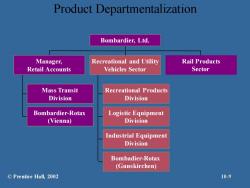
Product Departmentalization Bombardier,Ltd. Manager, Recreational and Utility Rail Products Retail Accounts Vehicles Sector Sector Mass Transit Recreational Products Division Division Bombardier-Rotax Logistic Equipment (Vienna) Division Industrial Equipment Division Bombadier-Rotax (Gunskirchen) ©Prentice Hall,.2002 10-9
Product Departmentalization Mass Transit Division Bombardier-Rotax (Vienna) Manager, Retail Accounts Recreational Products Division Logistic Equipment Division Industrial Equipment Division Bombadier-Rotax (Gunskirchen) Recreational and Utility Vehicles Sector Rail Products Sector Bombardier, Ltd. © Prentice Hall, 2002 10-9
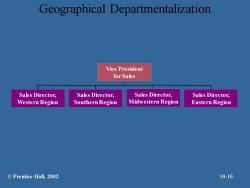
Geographical Departmentalization Vice President for Sales Sales Director, Sales Director, Sales Director, Sales Director, Western Region Southern Region Midwestern Region Eastern Region ©Prentice Hall,2002 10-10
Geographical Departmentalization Sales Director, Western Region Sales Director, Southern Region Sales Director, Eastern Region Vice President for Sales Sales Director, Midwestern Region © Prentice Hall, 2002 10-10
按次数下载不扣除下载券;
注册用户24小时内重复下载只扣除一次;
顺序:VIP每日次数-->可用次数-->下载券;
- 《管理学》课程PPT教学课件(Management, 7th Edition)Chapter 09 PLANNING TOOLS AND TECHNIQUES.ppt
- 《管理学》课程PPT教学课件(Management, 7th Edition)Chapter 08 STRATEGIC MANAGEMENT.ppt
- 《管理学》课程PPT教学课件(Management, 7th Edition)Chapter 07 FOUNDATIONS OF PLANNING.ppt
- 《管理学》课程PPT教学课件(Management, 7th Edition)Chapter 06 DECISION MAKING:THE ESSENCE OF THE MANAGER’S JOB.ppt
- 《管理学》课程教学资源(课件讲义)Stephen P.Robbins(9)Chapter 2 Management Yesterday and Today.pdf
- 《管理学》课程教学资源(课件讲义)Stephen P.Robbins(9)Chapter 1 Introduction to Management and Organizations.pdf
- 《管理学》课程教学资源(教师手册)Stephen P.Robbins(9)CHAPTER TWO Management Yesterday.pdf
- 《管理学》课程教学资源(教师手册)Stephen P.Robbins(9)CHAPTER ONE Introduction to Management.pdf
- 《管理学》课程PPT教学课件(Management)Stephen P.Robbins(9)第十二章 人力资源管理 Human Resource Management.ppt
- 《管理学》课程PPT教学课件(Management)Stephen P.Robbins(9)第十章 组织结构与设计 Organizational Structure and Design.ppt
- 《管理学》课程PPT教学课件(Management)Stephen P.Robbins(9)第十五章 理解群体与团队 Understanding Groups and Teams.ppt
- 《管理学》课程PPT教学课件(Management)Stephen P.Robbins(9)第十九章 运营及价值链管理 Operations and Value Chain Management.ppt
- 《管理学》课程PPT教学课件(Management)Stephen P.Robbins(9)第三章 组织文化与环境——约束力量 Organizational Culture and Environment - The Constraints.ppt
- 《管理学》课程PPT教学课件(Management)Stephen P.Robbins(9)第二章 管理的昨天和今天 Management Yesterday and Today.ppt
- 《管理学》课程PPT教学课件(Management)Stephen P.Robbins(9)第五章 社会责任与道德管理 Social Responsibility and Managerial Ethics.ppt
- 《管理学》课程PPT教学课件(Management)Stephen P.Robbins(9)第四章 全球环境中的管理 Managing in a Global Environment.ppt
- 《管理学》课程PPT教学课件(Management)Stephen P.Robbins(9)第六章 制定决策——管理者工作的实质 Decision-Making - The Essence of the Manager’s Job.ppt
- 《管理学》课程PPT教学课件(Management)Stephen P.Robbins(9)第八章 战略管理 Strategic Management.ppt
- 《管理学》课程PPT教学课件(Management)Stephen P.Robbins(9)第十六章 激励员工 Motivating Employees.ppt
- 《管理学》课程PPT教学课件(Management)Stephen P.Robbins(9)第十一章 管理沟通与信息技术 Communication and Information Technology.ppt
- 《管理学》课程PPT教学课件(Management, 7th Edition)Chapter 11 MANAGERIAL COMMUNICATION AND INFORMATION TECHNOLOGY.ppt
- 《管理学》课程PPT教学课件(Management, 7th Edition)Chapter 12 HUMAN RESOURCE MANAGEMENT(HRM).ppt
- 《管理学》课程PPT教学课件(Management, 7th Edition)Chapter 13 MANAGING CHANGE AND INNOVATION.ppt
- 《管理学》课程PPT教学课件(Management, 7th Edition)Chapter 14 FOUNDATIONS OF BEHAVIOR.ppt
- 《管理学》课程PPT教学课件(Management, 7th Edition)Chapter 15 UNDERSTANDING GROUPS AND TEAMS.ppt
- 《管理学》课程PPT教学课件(Management, 7th Edition)Chapter 16 MOTIVATING EMPLOYEES.ppt
- 《管理学》课程PPT教学课件(Management, 7th Edition)Chapter 18 FOUNDATIONS OF CONTROL.ppt
- 《管理学》课程PPT教学课件(Management, 7th Edition)Chapter 19 OPERATIONS AND VALUE CHAIN MANAGEMENT.ppt
- 《管理学》课程PPT教学课件(Management, 7th Edition)Chapter 20 CONTROLLING FOR ORGANIZATIONAL PERFORMANCE.ppt
- 《管理学》课程教学资源(实验讲义)企业竞争模拟攻略篇.pdf
- 《管理学》课程教学资源(习题与答案)第1章 管理活动与管理理论.doc
- 《管理学》课程教学资源(习题与答案)第3章 全球化与管理.doc
- 《管理学》课程教学资源(习题与答案)第6章 计划与计划工作.doc
- 《管理学》课程教学资源(习题与答案)第十章 组织变革与组织文化.doc
- 《管理学》课程教学资源(习题与答案)第16章 管理的创新职能.doc
- 《管理学》课程教学资源(习题与答案)第1章 管理活动与管理理论.doc
- 《管理学》课程教学资源(习题与答案)第3章 全球化与管理.doc
- 《管理学》课程教学资源(习题与答案)第4章 信息与信息化管理.doc
- 《管理学》课程教学资源(习题与答案)第5章 决策与决策方法.doc
- 《管理学》课程教学资源(习题与答案)第6章 计划与计划工作.doc
